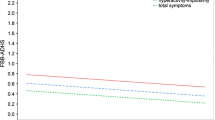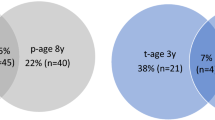Abstract
One hundred six clinic-referred boys meeting criteria for DSM-III-R attention-deficit hyperactivity disorder (ADHD) (mean age 9.4 years) were assessed annually for 4 years using structured interviews of multiple informants. Hyperactivity—impulsivity symptoms declined with increasing age, but inattention symptoms did not. Rather, inattention declined only from the first to the second assessment and remained stable thereafter in boys of all ages. The rate of decline in hyperactivity—impulsivity symptoms was independent of the amount and type of treatment received. Boys who still met criteria for ADHD in Years 3 and 4 were significantly younger, more hyperactive—impulsive, and more likely to exhibit conduct disorder in Year 1 than boys who no longer met criteria in Years 3 and 4.
Similar content being viewed by others
References
American Psychiatric Association. (1952).Diagnostic and statistical manual of mental disorders (1st ed.). Washington, DC: Author.
American Psychiatric Association. (1968).Diagnostic and statistical manual of mental disorders (2nd ed.). Washington, DC: Author.
American Psychiatric Association. (1980).Diagnostic and statistical manual of mental disorders (3rd ed.). Washington, DC: Author.
American Psychiatric Association. (1987).Diagnostic and statistical manual of mental disorders (3rd ed., rev.). Washington, DC: Author.
American Psychiatric Association. (1994).Diagnostic and statistical manual of mental disorders (4th ed.). Washington, DC: Author.
Barkley, R. A., Fischer, M., Edelbrock, C. S., & Smallish, L. (1990). The adolescent outcome of hyperactive children diagnosed by research criteria: I. An 8-year prospective follow-up study.Journal of the American Academy of Child and Adolescent Psychiatry, 29, 546–557.
Barkley, R. A. (1990).Attention-deficit hyperactivity disorder: A Handbook for diagnosis and treatment. New York: Guilford Press.
Bauermeister, J. J., Alegria, M., Bird, H. R., Rubio-Stipec, M., & Canino, G. (1992). Are attentional-hyperactivity deficits unidimensional or multidimensional? Empirical findings from a community survey.Journal of the American Academy of Child and Adolescent Psychiatry, 31, 423–431.
Costello, A. J., Edelbrock, C. S., Kalas, R., & Dulcan, M. (1984).The NIMH Diagnostic Interview Schedule for Children (DISC): Development, reliability, and comparison between clinical and lay interviewers. Worcester: University of Massachusetts Medical School.
Frick, P. J., Lahey, B. B., Applegate, B., Kerdyk, L., Ollendick, T., Hynd, G. W., Garfinkel, B., Greenhill, L., Biederman, J., Barkley, R. A., McBurnett, K., Newcorn, J., Waldman, I. (1994). DSM-IV Field Trials for the disruptive and attention deficit disorders: Diagnostic utility of symptoms.Journal of the American Academy of Child and Adolescent Psychiatry, 33, 529–539.
Gibbons, R. D., Hedeker, D., Elkin, I., Waternaux, C., Kraemer, H. C., Greenhouse, J. B., Shea, M. T., Imber, S. D., Sotsky, S. M., & Watkins, J. T. (1993). Some conceptual and statistical issues in analysis of longitudinal psychiatric data.Archives of General Psychiatry, 50, 739–750.
Gittelman, R., Mannuzza, S., Shenker, R., & Bonagura, N. (1985). Hyperactive boys almost grown up. I. Psychiatric status.Archives of General Psychiatry, 42, 937–947.
Hart, E. L., Lahey, B. B., Applegate, B., Hern, K., Hynd, G. W., Loeber, R., & Green, S. (1993) The factor structure of attention deficit disorder and implications for DSM-IV, npublished manuscript.
Hechtman, L., Weiss, G., Perlman, T., & Amsel, R. (1984). Hyperactives as young adults: Initial predictors of adult outcome.Journal of the American Academy of Child Psychiatry, 23, 250–260.
Hollingshead, A. B. (1975).Four factor index of social status. New Haven, CT: Yale University.
Klein, R. G., & Mannuzza, S. (1991). Long-term outcome of hyperactive children: A review.Journal of the American Academy of Child and Adolescent Psychiatry, 30, 383–387.
Lahey, B. B., Loeber, R., Stouthamer-Loeber, M., Christ, M. A., Green, S., Russo, M. F., Frick, P. J., & Dulcan, M. (1990). Comparison of DSM-III and DSM-R diagnoses for pre-pubertal children: Changes in prevalence and validity.Journal of the American Academy of Child and Adolescent Psychiatry, 29, 620–626.
Lahey, B. B., Pelham, W. E., Schaughency, E. A., Atkins, M. S., Murphy, H. A., Hynd, G. W., Russo, M. F., Hartdagen, S., & Lorys-Vernon, A. (1988). Dimensions and types of attention deficit disorder.Journal of the American Academy of Child and Adolescent Psychiatry, 27, 330–335.
Lahey, B. B., & Russo, M. F. (1989).Guidelines for “best-estimate” psychiatric diagnoses of children based on DISC interviews of child, parent, and teacher. Athens, GA: University of Georgia.
Lambert, N. M., Hartsough, C. S., Sassone, D., & Sandoval, J. (1987). Persistence of hyperactivity symptoms from childhood to adolescence and associated outcomes.American Journal of Orthopsychiatry, 57, 22–32.
Loeber, R., Green, S., Lahey, B. B., & Stouthamer-Loeber, M. (1991). Differences and similarities between children, mothers, and teachers as informants on disruptive child behavior.Journal of Abnormal Child Psychology, 19, 75–95.
Loney, J., Whaley-Klahn, M. A., Kosier, T., & Conboy, J. (1983). Hyperactive boys and their brothers at 21: Predictors of aggressive and antisocial outcomes. In K. T. Van Dusen & S. A. Mednick (Eds.),Prospective studies of crime and delinquency (pp. 181–206). Boston: Kluwer-Nijhoff.
Loney, J., Kramer, J., & Milich, R. (1981). The hyperkinetic child grows up: predictors of symptoms, delinquency and achievements at follow-up. In K. Gadon & J. L. Loney (Eds.),Psychosocial Aspects of Drug Treatment for Hyperactivity (pp. 381–415). Boulder: Westview Press.
Mannuzza, S., Klein, R. G., Bonagura, N., Malloy, P., Giampino, T. L., & Addalli, K. A. (1991). Hyperactive boys almost grown up: V. Replication of psychiatric status.Archives of General Psychiatry, 48, 77–83.
Minde, K., Weiss, G., & Mendelson, N. (1972). A 5-year follow-up study of 91 hyperactive school children.Journal of the American Academy of Child Psychiatry, 11, 595–619.
Pelham, W. E., Gnagy, E. M., Greenslade, K. E., & Milich, R. (1992). Teacher ratings of DSM-III-R symptoms for the disruptive behavior disorders.Journal of the American Academy of Child and Adolescent Psychiatry, 31, 210–218.
Piacentini, J., Cohen, P., & Cohen, J. (1992). Combining discrepant diagnostic information from multiple informants: Are complex algorithms better than simple ones?Journal of Abnormal Child Psychology, 20, 51–63.
Satterfield, J. H., Hoppe, C. M., & Schell, A. M. (1982). A prospective study of delinquency in 110 adolescent boys with attention deficit disorder and 88 nornal adolescent boys.American Journal of Psychiatry, 139, 795–798.
Shaffer, D., Gould, M. S., Brasic, J., Ambrosini P., Fisher, P., Bird, H., & Aluwhalia, S. (1983). A Children's Global Assessment Scale (CGAS).Archives of General Psychiatry, 40, 1228–1231.
Spitzer, R. L., Forman, J. B. W., & Nee, J. (1979). DSM-III field trials: I. Initial interrater diagnostic reliability.American Journal of Psychiatry, 136, 815–820.
Taylor, E., Sandberg, S., Thorley, G., & Giles, S. (1991).The epidemiology of childhood hyperactivity. New York: Oxford University Press.
Wechsler, D. (1974). Wechsler Intelligence Scale for Children-Revised. New York: Psychological Corporation.
Weiss, G., & Hechtman, L. (1986).Hyperactive children grown-up. New York: Guilford Press.
Weiss, G., Hechtman, L., Perlman, T., Hopkins, J., & Wener, A. (1979). Hyperactives as young adults: A controlled prospective 10-year follow-up of 75 children.Archives of General Psychiatry, 36, 675–681.
Author information
Authors and Affiliations
Additional information
This study was supported by grant 1-R01-MH42529 from the National Insitute of Mental Health to Rolf Loeber and Benjamin B. Lahey.
Rights and permissions
About this article
Cite this article
Hart, E.L., Lahey, B.B., Loeber, R. et al. Developmental change in attention-deficit hyperactivity disorder in boys: A four-year longitudinal study. J Abnorm Child Psychol 23, 729–749 (1995). https://doi.org/10.1007/BF01447474
Received:
Issue Date:
DOI: https://doi.org/10.1007/BF01447474




